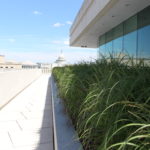The Embassy of Canada in Washington, D.C. has long been admired for its location and architecture, but the building also reflects Canada’s commitment to environmental protection. In June 2019, the Embassy earned the U.S. Green Building Council’s highest distinction — LEED® Platinum certification — for sustainable design and practices.
The Embassy achieved this distinction and, more importantly, reduced its environmental footprint by implementing numerous practical and measurable building improvements, such as:
- Electricity powered by 100% renewable energy (more on this below)
- Installation of new lighting technologies (annual reduction of over 525,000 kWh)
- Efficient water consumption (reduced usage by 660 cubic metres in 2018 and another 650 cubic metres in 2019)
- Thermal comfort control
- Extensive recycling and composting programs
These measures complement various other greening initiatives, including:
- Xeriscaping (resource-efficient native landscaping)
- Rooftop herb garden
- Monarch butterfly habitat station
- Employee bicycle program
- [NEW 2020] Two electric vehicle charging stations for employees
- [NEW 2020] Onsite urban bee hive installation
But our efforts do not stop there. The Embassy demonstrated continued commitment to sustainability in 2020 by entering a 3-year, 100% renewable contract, as part of a larger group of embassies. With support from the D.C. Greening Embassies Forum, all electricity use will be offset by a solar farm outside of Washington, D.C. Through this, the Embassy is projected to reduce CO2 emissions by at least 2,500 metric tons.
These efforts are just one piece of a broader Canadian commitment to clean energy innovation, efficiency and sustainability. Stay connected with us to learn more what we are doing to protect the environment at home and in the United States.
For more information about LEED Green Building Certification, go to: http://www.usgbc.org/







